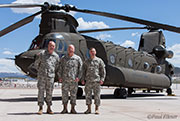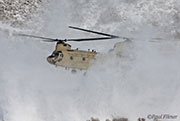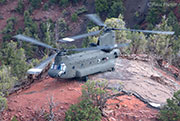Eagle County Airport, located in Gypsum, near Vail in Colorado is known for its unusual approach and departure procedures due to the surrounding terrain and is also home to frequent visitors in high-end business jets who own property in the area. Aircraft and helicopter manufacturers can also often be seen here with new aircraft undertaking high altitude testing programs. On the north side of the airport, however, is a small but vital component of the Colorado Army National Guard (CO ARNG); the High-Altitude ARNG Aviation Training Site commonly referred to as HAATS.
The original program started in 1985 as an internal component of the CO ARNG with the specific aim of training its own pilots at higher altitudes as SAR, flood relief and fire-fighting missions into the mountains were, at that time, originating at Buckley AFB located to the south-east of Denver, requiring flight to the west into the mountains and at higher altitudes. Although the area around Denver is already high at 5280 feet, and density altitude plays a huge part in all aviation here, once in the mountains operations up to 14,000 feet become even more problematic and critical with regard to aircraft operations.
Back then the helicopters such as the UH-1 and OH-6 were single engine machines with poor tail-rotor authority at altitude, so the Army needed to quickly become smart about flying in the mountains. Power management is the rule here with calculations being made at every stage of flight so the students get used to knowing what manoeuvres the helicopter is capable of performing, or more importantly what it cannot do.
Other units began asking for assistance in 1987 before their helicopters and crews were deployed to South America for Operation Golden Pheasant in March 1988. During this time the facility was known as the Colorado High-Altitude Training Site (CHATS). By 1991 it was recognised that this was an important program relevant to all US units and became a Federal Training site, receiving direct funding from the National Guard Bureau.
HAATS is one of four Army National Guard Aviation Training Sites (AATS) facilities in the USA, the others being Silverbell AAF in Arizona (Western ARNG Aviation Training Site - WAATS) for attack and reconnaissance using OH-58 and AH-64s, Fort Indiantown Gap in Pennsylvania (Eastern ARNG Aviation Training Site - EAATS) for utility and cargo missions using UH-60, UH72 and CH-47s, and Bridgeport, West Virginia (Fixed Wing ARNG Aviation Training Site - FWAATS) for fixed wing training on C-12, C-23 and C-26 aircraft.
HAATS is staffed by full-time Army National Guard Pilot Instructors (IPs) plus a small number of contract instructors who are ex-Army and extremely experienced. The main focus of the training is power management flight techniques while operating into confined spaces and small rough terrain landing zones (LZs) at altitude. This is often referred to as H3 at the base; high, hot and heavy.
Although five OH-58 Kiowas and four UH-60 Blackhawks are based permanently at the HAATS facility visiting units are encouraged to bring their own aircraft to train with. Many of these students come fresh out of flight school and most break their own altitude record by simply arriving at Eagle County Regional as it sits at an elevation of 6548 feet.
A typical flying day will start with a briefing for the instructors about crew assignments, the local aviation weather forecast, winds aloft, AIRMETS and SIGMENTS, NOTAMS and TFRs and notes about which LZs that each instructor intends to use for the day.
After this the students will go through the same briefing and go over any homework tasks they were given the night before. Further group training that relates to all helicopter types is also covered before they then break into their own small groups with their assigned Instructor Pilot (IP) to go over specific items for the day before the first flight.
A typical approach to a LZ will include a general reconnaissance flight over the LZ to gauge wind speed, wind direction, the terrain and hazards. Using tabular data the non-flying pilot will determine the current weight of the helicopter and the maximum power available at the altitude and temperature, plus the power required to hover in ground effect (IGE) and out of ground effect (OGE). This will show that in some cases, such as in a restricted area, you may have the power to land and to hover IGE, but insufficient power to get to OGE and over your obstacles, meaning that you will never leave.
A low-level flyby is then performed to further asses wind drift and to confirm or amend the observations made on the higher recon pass. The student is then expected to explain what power settings they will use, how and what direction they will approach from, how they will exit in an abort and then how they intend to depart the LZ. Departure or arrival may involve a tailwind component due to obstacles that cannot be overcome safely. Wind speed and direction are judged using visual, cockpit and flight manoeuvre indicators plus clues gained from observing the surrounding terrain.
One thing that training isn't provided for is night operations using night-vision goggles because the course is short and the time taken to transition from day to night operations is too great, however, the staff do maintain their own NVG capability due to the SAR role they are also tasked with. Course priority is given to units that are deploying to Afghanistan and then National Guard units that are based in mountainous regions.
There are currently 11 IPs on staff and each flies around 400-500 hours per year. There can be anything between seven and thirteen helicopters in training on any given week and the course lasts between four and five days dependent on weather. Two sorties are flown each day with one IP and two students per helicopter and each pilot will fly between 1.1 and 1.3 hours training per period. The H-60 and H-47s also carry a Crew Chief as in normal operations and their role is vital in confined areas and LZs with obstacles. One tank of gas is used per sortie, so as you can imagine, the training can be pretty intensive.
HAATS has around 900,000 acres of land at its disposal that is owned by both the US Forest Service and the Bureau of Land Management and most is within radio range of base where each helicopter checks in with "Eagles Nest" when they move to each LZ. This way Base Ops always knows who is where so that the other IPs that are airborne can avoid using the same LZ.
There are around 82 frequently used LZs and on day one they'll use those at lower altitudes and, as the days progress, the LZ difficulty rises. With the wind generally in the same direction all year round the IPs know the challenges each LZ poses and can tailor the day and the LZ to the current proficiency of the student. LZs can include confined areas, saddles, bowls, pinnacles and ridgelines, which provide challenges with power, wind, direction, blade clearance and downdrafts to name just a few. In the winter the problem of whiteout is apparent and can be used to effectively simulate the brown-out encountered in desert areas. Here the pilot must pick a reference point to land and keep that point visual in the chin-windows at his feet in order to land safely.
The Guard has permission to land anywhere within the area and not just at the LZs that are used frequently. Some areas have restrictions at certain times of the year as requested by the Division of Wildlife with big horn lambing, peregrine falcon nesting, and fawn and calf areas being some examples that they're required to stay clear off at certain times of the year. They also try to stay away from cabins and roads when it's obvious that people are present to try to stay as low-key as possible and be a good neighbour.
HAATS shuts down in October and November due to rifle hunting season, again at the request of the Division of Wildlife, as people pay a lot of money to hunt and they don't want helicopters flying low disturbing them. During that time IPs may get deployed to countries like Honduras, Korea, Germany, and Colombia to train US units in those areas.
Og's Hole, Ragged Edge, Willow Peak, Cattle Pond Blowout, Hard Scrabble Saddle and Dotsero Overlook all sound like ski trails but these are just some of the names of the LZs that are frequently used. Many have names already given by the local population or the Forest Service, but many others have interesting stories behind them:
Nick's Knob - an NCO (Non-Commissioned Officer) called Nick managed the trailer park that the LZ overlooks in Dotsero; it speaks for itself really!
By-U-Self - Some Louisiana Guard pilots were training here in the '90s one of the students just commented that you were "by you self" in his southern drawl when they landed here. The name stuck.
Mount Moore - named after Mike Moore who was one of the past IPs. It's a small pinnacle with a tree but some of the students complained that it was too tight, so one day the Safety Officer flew up with a chainsaw and chopped it down. The LZ is now called Mount Mo as it was cut short.
Dome Peak - is the highest LZ at 12,200 feet. Some years ago there was a guard unit training from one of the southern states and one of the pilots was typical 'old-school Guard', being slightly overweight and a smoker, so with the stick-buddy flying he asked if he could hop out for a smoke while they did another traffic pattern to land. So they left him on a rock and took-off, but when they came back he was nowhere to be seen. Hoping he hadn't fallen off the peak they got out of the helicopter and found him passed out and hypoxic lying behind a rock. They loaded him up and, while descending to 9,000 feet, he came to and of course denied everything.
The landings can get as high as 14,000 feet when the town of Leadville is included and this is a sometimes frequented lunch spot.
There have also been many foreign forces that have attended the HAATS training course including those from Denmark, Germany, Canada, Jordan, Norway and the Netherlands.
A new facility is being built, and the breaking ground ceremony took place on 22nd September 2011. It will include four hangar bays that can accommodate CH-47s, five classrooms, office space, 34 student rooms, a lounge area and an all round nicer and larger environment. This will negate the need to use hotels and keep everything independent and in-house.
There is no formal Army requirement for high altitude training so securing funding has been a challenge at times as HAATS has never had a task accredited course, but the base has recently been given the task of running a CH-47D Aircraft Qualification Course, and each one will run for ten weeks. HAATS is taking that role over from Foot Rucker which will concentrate solely on the CH-47F. Now, being task accredited and having a Military Occupational Specialty, funding should be largely guaranteed, hopefully securing the unit's future for a good while yet.
New Facility Opening - 26 April 2013
On 26 April 2013 the Colorado Army National Guard (CO ARNG) held a ribbon cutting ceremony for the new state-of-the-art training facility for the High Altitude Army National Guard Aviation Training Site (HAATS) in Gypsum, Colorado, located at Eagle County Airport.
Planned since 2005 to replace the much smaller original facility, with its roots reaching back to 1986, work commenced on 22 September 2011, and culminated in a 101,600 square foot facility being completed. The old facility is depicted below.
The 101st Army Band from Buckley AFB was scheduled to attend the ceremony, and I was invited along to cover the proceedings.
Our ride into the mountains was to be on a CH-47D, which was already loaded with the larger instruments belonging to the band. After our pre-flight safety briefing there was time for the band to pose with the helicopter while the crew readied the airframe.
Looking at their faces, it seemed like this was first helicopter flight for some of these guardsmen and women and this became even more obvious when the crew performed hover checks before departure!
We flew low over the mountains, partially following the I-70, and for a brief period of time the rear ramp was lowered so that the people sitting at the back could get a better view and take some pictures.
An hour later we arrived on the new ramp at HAATS. This ramp has, at the very least, doubled the parking space available for helicopters, in comparison with the area that was previously available.
I took the opportunity to get some shots of the interior of the building before most of the invited guests arrived for the ceremony.
The facility is light, airy, very well constructed and extremely pleasing to the eye from an aesthetic point of view. It has also gained a 'Leadership in Energy and Environmental Design' Silver Rating, which is fully certified through the U.S. Green Building Council.
The facility has offices for the instructor pilots, multiple, large classrooms and a whole wing that includes comfortable sleeping quarters for visiting crews, which means that everything is self-contained and it is, to all intents and purposes, self-sufficient.
The official ceremony started with a special presentation to two veterans of the 10th Mountain Division, which originated in nearby Camp Hale. This unit is considered to be one of the first high-altitude units and Sgt. Dick Dirkes and Chief Warrant Officer 2 Dick Over, the veterans in question, both served in WWII.
After the posting of the colours and the national anthem, played by the 101st Army Band, the speakers then took turns at the podium.
First to speak was U.S. Army Col. Andrew Meverden, Colorado National Guard State Chaplain, who gave the invocation, followed by Adjutant General of Colorado, Air National Guard Maj. Gen. H. Michael Edwards. Eagle County Commissioner Sara Fisher was next to speak, followed by Assistant Adjutant General of Army, Brig. Gen. Dana Capozzella, and the town of Gypsum's Mayor, Dick Mayne.
With such a mix of military and local dignitaries, it really drove home just how strongly the local community feels about the presence of HAATS in their area. As well as the high-altitude training, HAATS also performs the 'normal' duties of a National Guard unit, including, but not limited to, search and rescue and emergency evacuations.
Next up were two of the previous HAATS Commanders. Retired U.S. Army Brig. Gen. Joel Best, who's been here since the schoolhouse opened, basically said, "this place has been my life." Now working for Bell Helicopters, Joel related a couple of stories about how important and well-known this small facility is globally. These are better illustrated via the sound bite below.
General Joel Best
The second Commander was Lt. Col. Joshua Day, now Director of Aviation and Safety, and who served at HAATS until very recently. Joshua must be extremely proud of all the work that has been put into this project over the past ten years to get the new facility up and running. Just as he was promoted away from the mountains and back to Buckley, the new facility was finally completed, so it was fitting that he was in attendance.
Everything is now in the good hands of Maj. Tony Somogyi, who has also been attached to HAATS for many years. In fact, most of the instructor pilots (IP) have been here for a long time, such is the passion and importance of continuity for a unique training facility such as this.
Maj. Somogyi had the unenviable task of introducing all the speakers and keeping the pace of the ceremony moving, which, once it was complete, was followed by the raising of the colours at the entrance to the new HAATS building, and the ribbon cutting ceremony itself.
Cutting the ribbon, but not all visible in my photo, were retired U.S. Army Brig. Gen. Joel Best, U.S. Army Lt. Col. Joshua Day, U.S. Army Maj. Tony Somogyi, U.S. Air Force Maj. Gen. H. Michael Edwards, Sara Fisher, U.S. Army Brig. Gen. Dana Capozzella, and former U.S. Army Sgt. Dick Dirkes and Chief Warrant Officer 2 Dick Over.
This was followed by refreshments in the hangar and the cake cutting by Sgt. Dick Dirkes, formerly of the 10th Mountain Division.
I tried my hardest to get the last three HAATS Commanders together for a one-off photo opportunity, but it proved very difficult as they were all very busy, being pulled in all directions during the day. My flight was due to leave, but the Crew Chief on the CH-47D did a bit of quick thinking and found me a spare seat in a H-60 that was leaving later to fly back to Buckley AFB. Luckily this gave me the time to source the photo I was really after!
Subscribe to receive updates via: e-mail list | Facebook | Instragram | Twitter
Comments:25th February 2012 Walter Kuendig
Hi Paul, superb pictures, not just from the helicopters, also from the great scenery. You must have received a couple of interesting helicopter lifts! I have the wrong job...
[photo/serial list]


